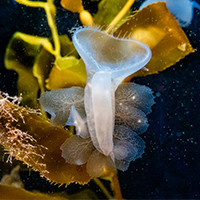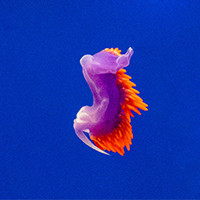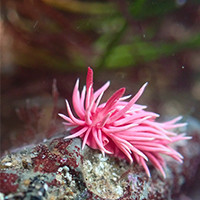City Nature Challenge
Calling all nature enthusiasts, the 2024 City Nature Challenge is here! This is a wonderful way to explore the outdoors, document local wildlife in San Diego County and help contribute to science. This challenge takes place from April 26 to 29 and we encourage you to upload photos of any wild plants and animals in San Diego County to the iNaturalist app.
How to participate in the 2024 City Nature Challenge:
- Download the free iNaturalist app to your phone
- Join the City Nature Challenge 2024: San Diego County iNaturalist project
- Snap a picture of any wildlife you see in San Diego and upload them to the project. Make sure you note the location of the critter or plant you find!
Our local tide pools are teeming with life and the perfect place to participate in the City Nature Challenge.

San Diego Sea Slugs
If you’ve ever spotted a tiny pop of color among the rocks, shells and sand while tidepooling, you’ve most likely spotted a sea slug – also known as a Nudibranch! Their soft and squishy bodies, graceful movements and incredible colors make them living works of art tucked beneath the ocean waves.
Many of these colorful creatures can be found at our local tide pools in La Jolla! Join us as we dive in and highlight some common sea slugs you can spot in San Diego. Depending on the time of the year, you can even find different sea slugs in the nursery habitats in the Hall of Fishes.
Lion’s Mane Nudibranch

While the Lion’s Mane Nudibranch looks out-of-this-world, you don’t have to travel across galaxies to see one! In addition to their alien-like translucent body, Lion’s Mane Nudibranchs eat with their entire head. These nudibranchs attach themselves to kelp and sway with the ocean waves to catch planktonic creatures in their magnificent “mane.” Once satisfied, they close their head to eat their snack!

Spanish Shawl
Have you ever seen a vibrant fiery orange and rich purple blob in a tide pool? If so, you’ve likely encountered the Spanish Shawl! This local, colorful sea slug gets its name from how it moves in the water. While most sea slugs crawl, this one “dances” back and forth while it swims. Many describe its swimming style as similar to the mesmerizing moves of Spanish dancers wearing traditional shawls!
California chromodorid

To no surprise, the California chromodorid is a tidepooling favorite among University of California folks thanks to its deep blue and golden coloration. While their vibrant colors make these slugs stand out, they’ve been hard to spot in local tide pools in recent years. These local legends have disappeared from La Jolla coasts, presumably due to environmental pressures from climate change and warming oceans. Fortunately, these sea slugs are slowly on the rise, and we can only hope their numbers continue to increase!

San Diego Dorid
This sea slug is none other than our aquatic, squishy neighbor, the San Diego Dorid! Notice that frilly feather-like structure that looks like a bunny tail? This “tail” is actually their gills! The scientific name Nudibranchia translates to “naked gills,” referring to the delicate feathery structures adorning the backs of sea slugs such as the San Diego Dorid. These gills are unique to each sea slug, adding a distinctive charm to these fascinating creatures.
Hopkin's Rose

Ever been entranced by a pop of rosy pink beneath the tides? You’ve most likely seen the Hopkin’s Rose Nudibranch! Named for its bold and bright coloration, this sea slug is hard to miss against the rocks, sand and algae in tide pools. It’s one of the common nudibranchs found in Southern California’s tide pools.